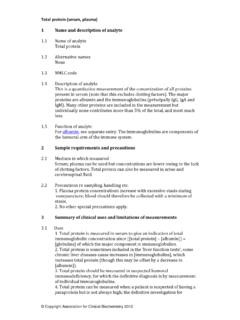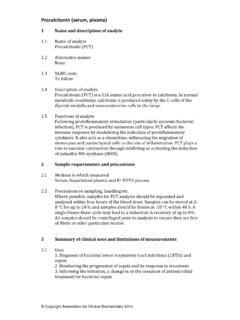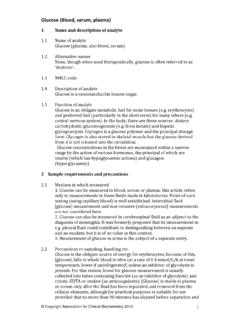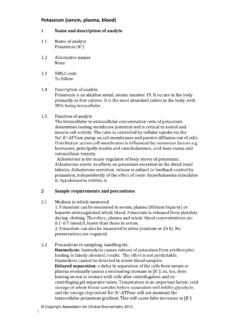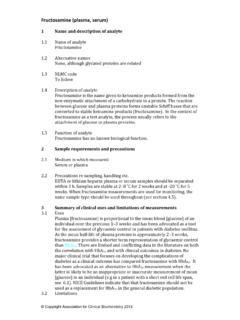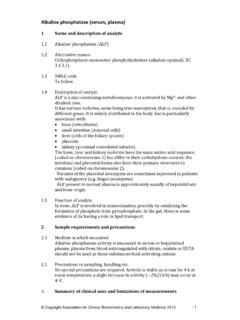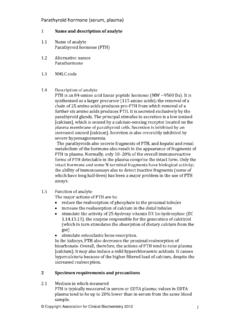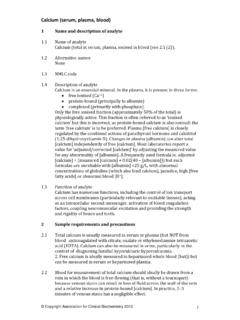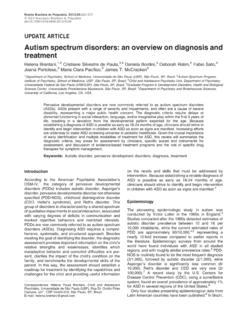Transcription of CA125 - Association for Clinical Biochemistry and ...
1 Copyright Association for Clinical Biochemistry 2012 CA125 (serum) 1 Name and description of analyte Name of analyte Cancer Antigen 125 ( CA125 ) Alternative names Mucin 16 NLMC code To follow Description of analyte CA125 is an antigenic determinant on a high molecular weight mucin like glycoprotein. It is recognised by the monoclonal antibody OC125, which was raised using an ovarian cancer cell line as an immunogen. CA125 is expressed by epithelial ovarian tumours and various other pathological and normal tissues of M llerian duct origin. Function of analyte The physiological function of CA125 is unknown but some sources suggest that it may provide a lubricating barrier against particles and infectious agents at mucosal surfaces.
2 2 Sample requirements and precautions Medium in which measured CA125 is measured in serum. Precautions re sampling, handling etc. General precautions only. 3 Summary of Clinical applications and limitations of measurements Uses CA125 is the most widely used tumour marker for epithelial ovarian cancer. 1. It is used in the differential diagnosis of ovarian cysts and pelvic masses in postmenopausal women. CA125 should be used in conjunction with transvaginal ultrasound scans (TVUS) for the calculation of the Risk of Malignancy Index (RMI) 2. It is measured in patients with ovarian cancer to assess response to chemotherapy and to detect tumour recurrence. 3. Since the NICE guidelines for the early recognition of ovarian cancer were published in April 2011 (see ), it is now recommended that individuals who present in primary care with symptoms suggestive of ovarian cancer have a CA125 measurement, to determine the need for further investigations including pelvic and abdominal ultrasound scans.
3 4. It is used to screen women with a family history of hereditary forms of ovarian cancer. Copyright Association for Clinical Biochemistry 2012 Limitations At present, the value of screening asymptomatic post menopausal women for ovarian cancer by measuring CA125 remains uncertain and is not recommended. Results from the current prospective UK Collaborative Trial of Ovarian Cancer screening (UKCTOCS) are not expected until 2014. The Prostate, Lung, Colorectal and Ovarian (PLCO) randomised controlled trial in the United States found no decrease in mortality rates as a result of screening with CA125 . 4 Analytical considerations Analytical methods CA125 is measured by immunoassay. Reference method None reported. Reference materials. An international reference preparation is not currently available.
4 Interfering substances As with all immunometric assays, there is a potential for interference by in vivo heterophilic antibodies. Results must always be considered in relation to the Clinical situation and to previous assay results, if available. The latter is particularly important when serial results are being used for monitoring the response to treatment. Sources of error At very high concentrations, there is a risk of generating falsely low values as a result of the high dose hook effect. 5 Reference intervals and variance Reference interval (adults): the upper reference limit is 35 IU/mL but may be higher in pre menopausal women. Reference intervals (others): not applicable. Extent of variation Interindividual CV: this is not a useful concept with tumour markers.
5 Intraindividual CV: 29% CV of method: 4% (using QC data. Analysed on Siemens Advia Centaur, 2nd generation two site sandwich immunoassay). Critical difference= Sources of variation Serum [ CA125 ] decreases with aging and after the menopause. [ CA125 ] has been shown to vary 20 50% between different ethnic groups in post menopausal women, with concentrations being lower in African American women than in white women. Menstrual cycle variations also occur and [ CA125 ] is raised in pregnancy. 6. Clinical uses of measurement and interpretation of results Uses and interpretation 1. Differential diagnosis of pelvic masses and adnexal cysts Copyright Association for Clinical Biochemistry 2012 Measurement of CA125 is recommended as an adjunct in distinguishing benign from malignant suspicious pelvic masses, particularly in postmenopausal women.
6 [ CA125 ] is used in conjunction with TVUS to calculate the risk of malignancy index (RMI). [ CA125 ] is multiplied with the ultrasound score (U) and menopausal status (M) to calculate the Risk of Malignancy Index (RMI) score: RMI= U x M x CA125 The RMI forms the basis of patient pathway guidelines for the management of pelvic masses and adnexal cysts. 2. Monitoring response to treatment and tumour recurrence. A persistently increasing CA125 value may be associated with progressive malignant disease, poor therapeutic response or relapse, whereas a declining CA125 value indicates a favourable prognosis and good therapeutic response. The half life of CA125 is 5 10 days. 3. Patients presenting to GPs with symptoms suggestive of ovarian malignancy Since the publication of NICE guidelines CG122 in April 2011 it is now recommended that CA125 should be measured in women who present to primary care with persistent symptoms (particularly occurring >12 times per month) that are consistent with ovarian cancer.
7 These include abdominal distension, early satiety, loss of appetite, pelvic or abdominal pain and increased urinary urgency and/or frequency. If the serum CA125 is 35 IU/mL, an ultrasound scan of the abdomen and pelvis should be performed with calculation of RMI as above. 4. screening CA125 is recommended, together with TVUS, for early detection of ovarian cancer in women with hereditary ovarian cancer syndromes, in whom early intervention may be beneficial. Confounding factors 1. Serum [ CA125 ] is elevated in only 50% of patients in the early stages of ovarian cancer, when treatment is most effective. 2. Specificity is poor: serum [ CA125 ] is raised in a number of other benign and malignant conditions (see ) 3. Pre menopausal women are more likely to have falsely elevated [ CA125 ] levels than post menopausal women due to either menstruation or pregnancy.
8 7. Causes of abnormal results High values Causes Gynaecological malignancy o epithelial ovarian carcinoma o adenocarcinoma of the endometrium o carcinoma of the fallopian tube o uterus (uncommonly). Other malignancies o Colon, rectum o liver o lung Non malignant conditions, o pregnancy Copyright Association for Clinical Biochemistry 2012 o menstruation o ascites o peritoneal or pleural inflammation o benign ovarian cysts o endometriosis o uterine fibromyomata (fibroids) o pelvic inflammatory disease o cirrhosis. During menstruation [ CA125 ] can increase 2 3 fold; it can increase to 1000 IU/mL in patients with ascites. Investigation CA125 should only be measured when there is a Clinical suspicion of ovarian cancer or a patient is at high risk of ovarian cancer.
9 Further investigations will depend on the Clinical context but may need to include exclusion of non malignant conditions as well as investigations directed towards diagnosing ovarian cancer (particularly ultrasound). Low values Causes CA125 should be undetectable or present in only very low concentrations in healthy individuals; the concept of a low value is not applicable. Investigation Not applicable. Notes None 8. Performance Medeiros et al (2009) (see ) conducted a systematic review and meta analysis of CA125 measurement for the discrimination of malignant/borderline malignant tumours from benign tumours in women with clinically suspected adnexal masses. Using a threshold [ CA125 ] of 35 U/mL to signify malignancy, the sensitivity and specificity of CA125 was estimated as 80% (95% CI 76 82%) and 75% (95% CI 73 77%), respectively.
10 Similarly, in their systematic review of 46 studies, Myers et al (2006) (see ) estimated the sensitivity and specificity of CA125 as 78% (95% CI 75 81%) and 78% (95% CI 71 82%), respectively. 9. Systematic reviews and guidelines Systematic reviews 1. Medeiros LR, Rosa DD, da Rosa MI, Bozzetti MC. Accuracy of CA125 in the diagnosis of ovarian tumours: a quantitative systematic review. Europ J Obstets Gynecol Reprod Biol 2009;142:99 105. A quantitative systematic review to estimate the accuracy of CA125 assay in the diagnosis of ovarian tumors. A total of 17 studies were included that evaluated CA125 levels for the diagnosis of ovarian tumors and compared them with paraffin embedded sections as the diagnostic standard. 2. Myers ER, Bastian LA, Havrilesky LJ et al.
